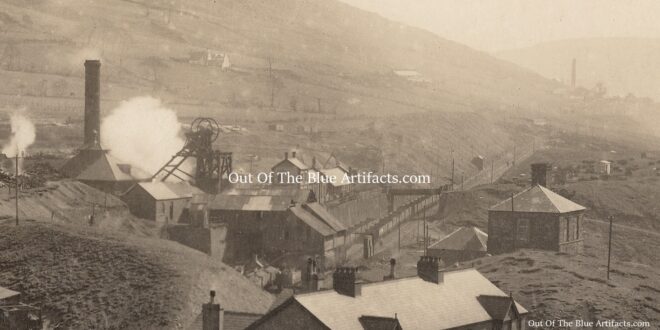The Lower Deep Colliery.
Originally one of two collieries which were situated close to Cwmcelyn, Blaina, the other being the Upper Deep Colliery, both owned by the Nantyglo Iron and Coal Company.
Blaina Iron and Coal Company.
In July 1869 the Blaina Iron and Coal Company was formed and leased the Blaina Iron Works. Mr James Clarke was the general manager.
Nantyglo and Blaina Iron Works Company Ltd.
In July 1871 the Blaina Iron and Coal Company purchased the Nantyglo and Beaufort Iron Works and was re-named the Nantyglo and Blaina Iron Works Company Ltd.
Managing Directors were – Mr W. N. Massey (Chairman); Mr James Carlton Esq (Deputy-Chairman); Lieutenant Colonel P. T. French; Mr John Grave Esq, Mayor of Manchester; Sir Joseph Heron; Lord Henry G. Lennox, M.P. London; Mr E. J. Reed Esq, C.B. (Late Chief Constructor of Her Majesty’s Navy) London and Mr John Richardson:
Messrs Bischoff, Bompas & Bischoff (Solicitors of London). Mr John Roberts (Secretary).
Offices – 8 Great Winchester Street Buildings, London.
The new company was formed to acquire the Iron Works of Nantyglo, Beaufort, Blaina, Cwm Celyn and the Trostre Works and to amalgamate the whole under one company.
It was reported that the Nantyglo Iron Works was purchased for £480,000 and the Blaina Iron Works for £200,000. The works were carried on with many workers being employed, though in 1873 the Great Strike put many men out of work, the shareholders became dissatisfied with the administration and a new board of directors of Mr Hugh Mason and Mr Richard Shaw. Mr Spencer was the manager of the works and lived at Nantyglo House.
The iron trade was coming to an end and in 1874 and the Iron Industry at Nantyglo and Blaina came to a near standstill. The Nantyglo and Blaina Iron Works Ltd abandoned their Iron Works and was reorganised into a Land, Estate, Property and Mineral concern.
In 1874 Beaufort Works closed, though was later leased by Mr William Lewis of Church Cottage, Beaufort, owner of several collieries.
In 1875 the Nantyglo and Blaina Iron Works Company Ltd suffered great financial losses and Mr Richard Shaw resigned the chairmanship of the company. Mr Hugh Mason Esq took control with a new Director Mr Samuel Ogden.
The Sell Off.
In 1877-78 some assets were sold off or leased.
Messrs Battersby and Co of Liverpool.
On Monday 12th of February 1877, Messrs Battersby and Co of Liverpool with their consulting engineer Mr Sugden accompanied by Mr S. Griffiths, the colliery manager of the Nantyglo Iron and Coal Company, visited the Upper and Lower Deep Collieries of the company at Blaina and inspected both pits with a view to leasing. Messrs Burgess and Shaddick and Co of Cardiff also visited the Henwain Colliery with a view to leasing that colliery. Nothing more of this proposed lease was ever mentioned in local papers.
Mr John Lancaster & Co.
In March 1878 the Collieries of the Nantyglo and Blaina Iron Works Ltd were leased by Mr John Lancaster of Wigan.
Winder Accident.
On Tuesday 20th of February 1906, the cage was being lowered down the shaft at the Lower Deep Colliery, Blaina when the engine ran wild. At the time nine men were in the cage, which descended 180′ feet at a terrific rate, they had a miraculous escape sustaining no more than a severe shaking. It was reported that the crank-pin of the winding engine shook loose.
Workforce.
On Saturday 27th of September 1913, the Western Mail newspaper reported that there were 1,200 men out of work at the Lower Deep Pit as the result of a dispute at the colliery.
Winding Accident.
On Saturday 1st of August 1914, another winding accident occurred, eight men were in the cage being lowered when the engine failed, five men were seriously hurt as the cage fell to pit bottom. It was reported all the men came out of the pit and it remained idle until after the holidays as a consequence of the accident.
Workforce.
In 1916 the workforce at the Lower Deep Colliery was 900 men, as reported in the South Wales Gazette on Friday 12th May 1916.
The Ebbw Vale Company.
In July 1915 the collieries of Messrs Lancaster were under the control of Messrs D. Davies and Co.
Beynon’s Colliery.
In the early 1920’s the Beynon’s Colliery was sunk. All the other main seams were passed through and tunnels were driven from the North Blaina and the Lower Deep to enable all coal to be delivered to the pit-bottom of the new pit from those present workings. (The Henwain Colliery had already closed by this time) It was projected that in the future a cross measure drift be driven to reach new areas of coal.
The Power House Fire.
On Tuesday 28th of August 1923, a fire broke out in the power-house of the Lower Deep Colliery, Blaina. It was caused by the fusing of some electric wire and was mostly confined to the roof of the building. A dynamo which controlled the underground haulage and also some of the underground lighting was damaged although it caused little inconvenience to the men working below ground.
Closure of the Lower Deep Colliery.
On 3rd September 1923 the Ebbw Vale Company closed the Lower Deep Colliery, Blaina.
Points of Interest – The Lower Deep Colliery can be seen in the main image, the Henwain Colliery part of the group of the Blaina Collieries can be seen in the distance (far right).
 Out Of The Blue Artifacts A Library of a lifetime of collecting
Out Of The Blue Artifacts A Library of a lifetime of collecting
